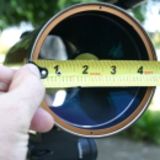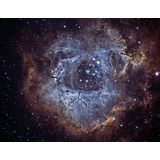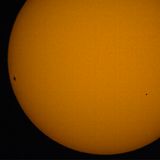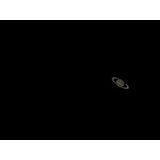
Get outside with your telescope on clear May evenings to see celestial treats in the sky! With weather warming up and skies clearing up, there's no shortage of celestial delicacies to view. Here are a few of Orion's top suggestions for May observing:
Eta Aquarid Meteor Shower - Get outside well before dawn on May 5th to catch the Eta Aquarids. You don't need a telescope to enjoy this meteor shower, which should deliver about one meteor per minute. Look for meteors appearing to radiate out of the water jug portion of the constellation Aquarius.
Dancing Planets - Between May 10th and May 30th, there will be a wonderful conjunction of three bright planets and the Moon. Jupiter, Venus and Mercury will entertain us as they dance across the western sky, with Jupiter and Venus coming within a single degree of each other on May 28th. Use a telescope to see planetary details, or use unaided eyes to witness this great gathering of planets shortly after dusk.
Stellar Occultation - During the evening of May 24th, watch as the nearly Full Moon will cover up the bright star Beta Scorpii. This "occultation" will only be visible from the Midwest and Southeast, but lucky observers thereabouts can see the bright star "blink out" as the Moon covers it. If you've never had the pleasure of seeing an occultation, be sure to make the most of this opportunity - it's simply incredible to see how fast the star appears to "hide" behind the Moon!
The Ringed Planet - A perennial favorite of amateur astronomers around the world, ringed Saturn will be nicely positioned in May skies for telescopic study. Saturn reached opposition in April and will steadily rise higher in the night sky as May progresses. As it gets higher in the sky, views of Saturn and its stunning rings will get better and better! While you can detect the rings in a small telescope like the 76mm FunScope, bigger telescopes such as an XT6 or XT8 Dobsonian will provide significantly better views of Saturn.
Four Big Planetary Nebulas - Use a 6" or larger telescope and an O-III or UltraBlock filter to catch four relatively large planetary nebulas in May skies. See the "Ghost of Jupiter," NGC 3242 in Hydra; M97, "the Owl Nebula" in the Big Dipper; NGC 4361 in Corvus, and the famous "Ring Nebula", M57 in Lyra just a few degrees from bright star Vega.
Four Glittering Globulars - Four picture-perfect examples of globular star clusters will be visible in May skies. Check out M3 in the constellation Bo÷tes. M13, the "Great Cluster in Hercules" will be visible near the zenith. M5 can be found in Serpens, and M92 in the northern section of Hercules. Big telescopes will provide the best views, but even 50mm binoculars will show you these dense balls of stars from a dark sky site.
Four Face-On Spirals - Use large telescopes to see the classic pinwheel shapes of galaxies M51 and M101 in the Big Dipper asterism, and M99 and M100 in the Virgo galaxy cluster. There are also dozens of additional galaxies to explore in the Virgo cluster with a big-aperture telescope.
May's Challenge Object - May skies present perhaps the best opportunities to grab a view of Omega Centauri - the brightest globular star cluster in the sky! While it's big and bright, even visible as a "fuzzy" star in binoculars, the challenge Omega Centauri presents is its low position in southern skies, which can make it unobservable from higher northern latitudes.
All objects described above can easily be seen with the suggested equipment from a dark sky site, a viewing location some distance away from city lights where light pollution and when bright moonlight does not overpower the stars. All objects have been verified by actual observations by Orion Telescopes & Binoculars Staff at Fremont Peak State Park, and/or Deep Sky Ranch, 60 miles and 90 miles respectively from San Jose International Airport, San Jose, CA.





















